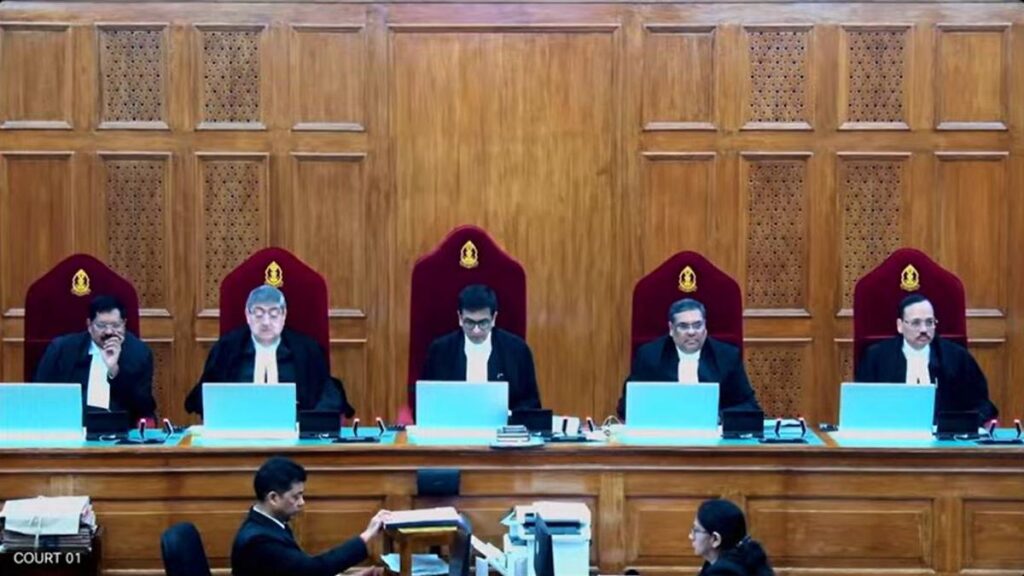
Live Explanation of Supreme Court’s Decision on the Abrogation of Article 370: The Court instructs the Centre to reinstate Jammu and Kashmir’s statehood and conduct assembly elections by September 2024.
“Live Explanation of Supreme Court’s Ruling on the Abrogation of Article 370: A five-judge Constitution bench, led by Chief Justice of India DY Chandrachud, had reserved its decision on September 5 this year. Here, we provide an overview of the verdict and its context.”
Live Explanation of Supreme Court’s Verdict on the Abrogation of Article 370: Today, on December 11, the Supreme Court delivered its judgment on the Union government’s 2019 decision to amend Article 370 of the Constitution, which resulted in the removal of the special status granted to the former state of Jammu and Kashmir. The court affirmed the Constitutional validity of the order that abrogated Article 370.
The five-judge Constitution bench, headed by Chief Justice of India (CJI) DY Chandrachud, had reserved its decision on 23 petitions related to the matter after 16 days of hearings on September 5 this year. The bench also included Justices S K Kaul, Sanjeev Khanna, B R Gavai, and Surya Kant.
CJI DY Chandrachud, while delivering the verdict, emphasized that Jammu and Kashmir lost its internal sovereignty upon acceding to India. The court found no prima facie evidence suggesting that the President’s 2019 orders were an improper use of power. Although the court acknowledged the 2019 reorganization of the erstwhile state into Union Territories as a temporary measure, it directed the Centre to work towards restoring statehood.
In a concurring opinion, Justice Kaul proposed the establishment of a Truth and Reconciliation Commission in J&K. This commission would aim to acknowledge alleged violations committed by the State and its actors.”
“Live Explanation of Supreme Court’s Ruling on the Abrogation of Article 370: Justice Khanna presents his separate, concurring opinion, asserting that Article 370 exemplifies asymmetric federalism and does not signify the sovereignty of Jammu and Kashmir. He emphasizes that the abrogation of Article 370 does not undermine federalism.
In a related development, Justice Kaul suggests the establishment of a Truth and Reconciliation Commission to investigate reported human rights violations by both state and non-state actors in Jammu and Kashmir. He emphasizes that such a commission should be based on dialogue rather than functioning as a criminal court. Truth and Reconciliation Commissions, prevalent in numerous countries in Latin America, Africa, and beyond, aim to investigate allegations of rights abuses and contribute to the restoration of peace within communities through the dispensation of justice.”
“Live Explanation of Supreme Court’s Ruling on the Abrogation of Article 370: Justice Kaul initiates the presentation of his concurring opinion, invoking ‘The people of Kashmir.’ He aligns his conclusions closely with the Chief Justice’s perspective, emphasizing that the J&K Constitution aimed at facilitating everyday governance and Article 370 intended to integrate the state with India.
Justice Kaul incorporates a ‘sentimental’ epilogue in his opinion, highlighting the historical burden borne by the valley of Kashmir. He emphasizes the centrality of ‘We the people of Jammu and Kashmir’ in the ongoing debate. Justice Kaul critiques the role of the military, stating that armies are designed for battles against enemies, not for maintaining law and order. He acknowledges the heavy toll paid by men, women, and children due to the presence of the army.
The Chief Justice then addresses the reorganization of Jammu and Kashmir into Union Territories, emphasizing that the Union Territory status is deemed temporary. The court refrains from determining the validity of this reorganization, given the Centre’s assertion of its temporary nature. The restoration of statehood to J&K is directed, with the Election Commission of India instructed to conduct elections to the Legislative Assembly by September 30, 2024.
CJI Chandrachud proceeds to read the verdict, emphasizing that Article 370 was a temporary provision. He elucidates that it served a transitional purpose and addressed the war-like situation prevailing in the state at the time.
The Supreme Court frames several critical questions, including the nature of Article 370, the validity of the 2019 amendments, and the constitutionality of the reorganization. CJI Chandrachud continues by elucidating that Jammu and Kashmir did not enjoy a unique relationship with the Indian Constitution, holding no internal sovereignty after accession to India.
As the judgment unfolds, the court provides insights into the historical context, the impact on Jammu and Kashmir since August 2019, and the significant legal questions addressed. Stay tuned for further details as the live coverage continues.”
“How Article 370 Was Revoked: Historical Context
Governor’s Rule was enforced in Jammu and Kashmir on June 19, 2018, following the BJP’s withdrawal of support to the coalition government led by People’s Democratic Party (PDP) leader and Chief Minister Mehbooba Mufti. According to Article 92 of the J&K Constitution, a mandatory six-month period of Governor’s Rule was necessary before the state could be placed under President’s Rule.
The Legislative Assembly was dissolved on November 21, and by December 12, before the completion of the six-month period, President’s rule was imposed on J&K. Both Houses of Parliament subsequently approved President’s Rule.
On June 12, 2019, President’s Rule was extended for an additional six months, effective from July 3 of that year.
On August 5, the Central government issued an order amending The Constitution (Application to Jammu and Kashmir) Order, 1954, superseding it with The Constitution (Application to Jammu and Kashmir) Order, 2019. The new order rendered “all the provisions of the Constitution” applicable to J&K state. Simultaneously, the government amended Article 367 by adding a new Clause (4), making the Constitution of India directly applicable to J&K.
On August 6, the President issued a declaration under Article 370(3), rendering all its clauses inoperative, except for the provision stipulating that all articles of the Constitution shall apply to J&K.”
